begin quote from:
https://www.smithsonianmag.com/arts-culture/voyage-french-polynesia-herman-melville-course-write-moby-dick-180972525/
How a Voyage to French Polynesia Set Herman Melville on the Course to Write ‘Moby-Dick’
We retrace the journey that had a long-lasting influence on the enigmatic author’s improbable career
/https://tf-cmsv2-smithsonianmag-media.s3.amazonaws.com/filer/2b/af/2bafaa65-8666-4b73-905c-8de5e845adf7/julaug2019_g12_melville.jpg)
1
This is the tale of a man who fled from desperate confinement, whirled into Polynesian dreamlands on a plank, sailed back to “civilization,” and then, his genius predictably unremunerated, had to tour the universe in a little room. His biographer calls him “an unfortunate fellow who had come to maturity penniless and poorly educated.” Unfortunate was likewise how he ended.
Who could have predicted the greatness that lay before Herman Melville? In 1841, the earnest young man sneaked out on his unpaid landlady and signed on with the New Bedford whaler Acushnet, bound for the South Seas. He was 21, eager and shockingly open-minded, yearning not just to see but to live. In Typee (1846) and Omoo (1847) and the other seafaring novels inspired by his exploits over the next three years, written in the half-decade before he commenced Moby-Dick, his word-voyage aboard the Pequod, Melville wrote with bighearted curiosity about fearsome “savages” and cultural otherness. To honor this prophet of empathy, this spring I set out for French Polynesia, to see some of the watery part of the world, and to view what I could of the place and its inhabitants, which formed in our novelist his moral conscience and gave unending sail to his language and his metaphors. Back in America, he had to learn to savor these gifts, for after tasting briefly of success he would not have much else to sustain him.
2
Herman Melville was born 200 years ago, on August 1, 1819. Both of his grandfathers were celebrities of the Revolutionary War. His mother’s father, Peter Gansevoort, had defended Fort Schuyler against the Redcoats. His father’s father, Thomas Melvill (no “e”), one of Samuel Adams’ co-conspirators, took part in that infamous hooliganism called the Boston Tea Party. After victory they both came into money. Unfortunately for Herman Melville, his father, Allan, borrowed heavily from many quarters, including his wife’s not yet allotted inheritance, concealing debts, skipping out on creditors.
Allan died in 1832. Now Herman, age 12, had to leave school to toil at the New York State Bank, of which his unforgiving benefactor Uncle Peter was one of the directors. From this torture the boy was pulled out to labor at his elder brother Gansevoort’s furrier establishment, which presently failed. We glimpse him back in school, then out again: a would-be canal surveyor, and probably a hired laborer. “Sad disappointments in several plans which I had sketched for my future life,” runs the opening page of his fourth novel, Redburn (1849), a crowd-pleaser about a naif on his first voyage among rough sailors, ringing highly autobiographical. “The necessity of doing something for myself, united to a naturally roving disposition, had now conspired within me, to send me to sea as a sailor.”
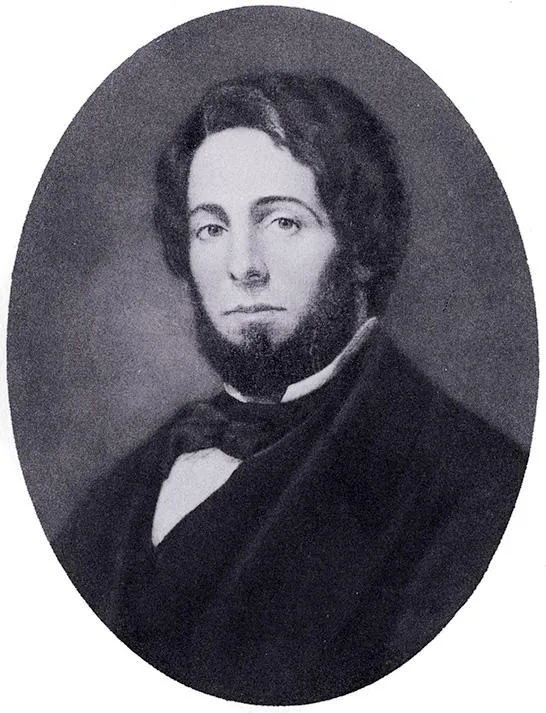
In 1839, Melville signed up as a deckhand on the St. Lawrence to Liverpool. He was gone from June to October—barely long enough to peep into the wider world. In January 1841 he absconded again, this time to board the whaler Acushnet.
It was on the Acushnet that Melville read The Narrative of the Most Extraordinary and Distressing Shipwreck of the Whale-Ship Essex, a memoir of the expedition whose destruction, out on Pacific waters after a gigantic sperm whale smashed its head into the ship, gave our not-yet author a first inkling of the plot of his greatest work. In the 19th century, of course, whales were not intelligent creatures to be protected but monsters to be monetized. “For, thought Starbuck,” chief mate of the Pequod in Moby-Dick, “I am here in this critical ocean to kill whales for my living, and not to be killed by them for theirs.”
By June 1842, having sailed south around Cape Horn and into the Pacific, the Acushnet had filled 750 barrels with whale oil. Melville wrote later about how it would have been obtained:
“The red tide poured from all sides of the monster like brooks down a hill. His tormented body rolled not in brine but in blood, which bubbled and seethed for furlongs behind in their wake. The slanting sun playing upon this crimson pond in the sea, sent back its reflection into every face, so that they all glowed to each other like red men....Starting from his trance into that unspeakable thing called his ‘flurry,’ the monster horribly wallowed in his blood, overwrapped himself in impenetrable, mad, boiling spray....At last, gush after gush of clotted red gore...shot into the frighted air: and falling back again, ran dripping down his motionless flanks into the sea. His heart had burst!”
After 18 months at sea, Melville was getting sick of the whole business. In Typee, his first novel—a mix of autobiography, fabulist chicanery, and unattributed borrowings from many earlier works, in which he dramatized the time he spent among Polynesian cannibals until, fearing for his life, he fled—Melville, in the guise of a character called Tom, denounced the Acushnet’s captain as a tyrant, pronounced the voyage overprotracted, bemoaned the food. I myself would have declined whale-cruising on first sight of those dark and filthy cubbyholes set in around the bow, their wood on the verge of decay—how they must have stunk! Here slept the crew, sometimes for two or three years at a stretch.
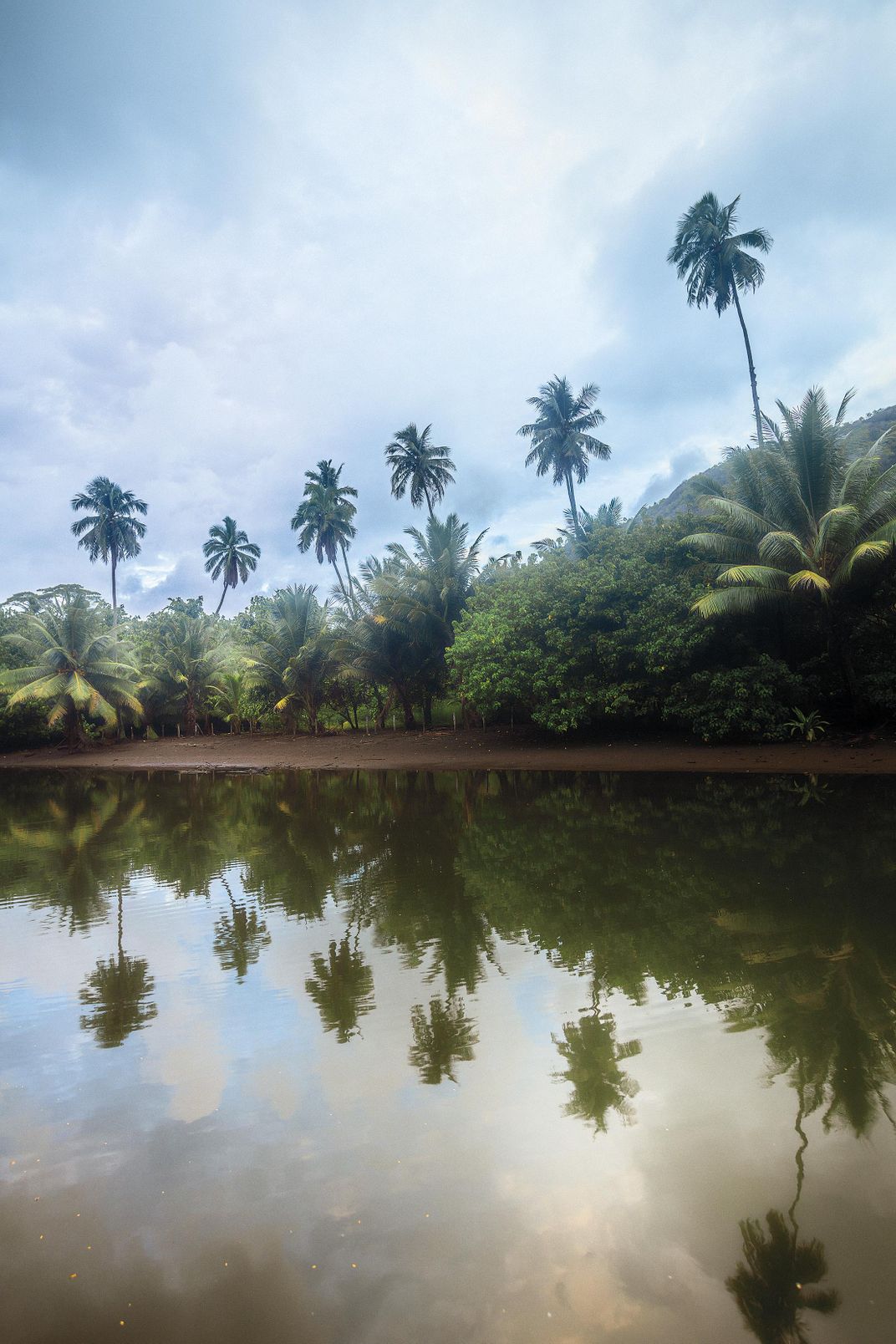
Coming into Taiohae Bay, off Nuku Hiva, part of a Polynesian island group called the Marquesas, Melville wrote in Typee that the beauty of the harbor “was lost to me then,” seeing as he could focus only on six French warships. He happened to be arriving as the French and British were openly competing for Polynesian converts and territory. That year, a French admiral named Abel Aubert du Petit-Thouars sweet-talked the archipelago’s chiefs, who imagined they were getting protection, into signing annexation treaties.
What might have been going on there in June of 1842? One badly reproduced engraving from a “commemorative” 1992 booklet is at least said to derive from that very month. In it we see the bay crawling with ships and boats, not to mention what might be a native canoe, while onshore stand at least two rows of stout-looking French edifices, evidently of stone or brick. As the Melville scholar John Bryant, founder of the journal Leviathan and editor of the Penguin Typee, remarks: “The young whaler had come to Nuku Hiva at precisely the moment in which that island culture was about to die.” Melville was not shy in condemning what he saw. One of Typee’s page headings reads: “REFLECTIONS ON EUROPEANS’ CRUELTIES.”
Corinne Raybaud, a French historian who has lived in Tahiti for 40 years, and has much to say about our author’s Polynesian travels, told me that Melville wasn’t the first Anglo to visit Nuku Hiva, but he might have been the first, or among the first, to dwell with that island’s most anti-European tribe, the Typee—or, as they now orthographize themselves, the Taipi. Her best guess was that he was there, all told, for three weeks.

For Melville, the lure, I think, was the idea of Polynesia. As one American missionary reported of his encounters there, a dozen years before Melville took to sea, “I am more and more disgusted with the nakedness and a hundred other of the odious appurtenances of heathenism forced on us at every turn.” Those “appurtenances” made many a young man’s heart sing, as Melville would have known: He had a cousin aboard that missionary’s very ship. How must this idea of Polynesia have inflamed our raw young American, who came from drudgery, shame, worry and degradation? What must it have been like for him, undernourished in experience and overfed on Christian pieties, to chart his own moral course on this partially unmapped continent?
3
Today, Taiohae Bay’s astonishingly blue water-circle is softly enwrapped by the curves of high green promontories decorated by rain and ferny jungle. My first impression of it, descending a serpentine route from Nuku Hiva’s dry side, consisted of golden light shooting down across the tops of palms and banana trees in the slanting valley, and a sudden cleanly bitter fragrance. Two days later, Taiohae’s circlet of hills was drier, and some of the glow had bled out of the sky. On another drizzly morning the bay wore brilliant mirror-gray, like a daguerreotype. I thought I scented pua blossoms.
Once at anchor, the Acushnet’s captain, upon releasing the men for shore leave, could not abstain from warning against the “tattooed scoundrels” who might inveigle them into a stew pot. The legend of those scoundrels preceded them. As Typee relates, “Their very name is a frightful one; for the word ‘Typee’ in the Marquesan dialect signifies a lover of human flesh.” Evidently not so frightful as to forestall shore leave, however. How could such cautions win out against testosterone and earnest curiosity? Off rowed the starboard watch, Melville among them. It was July 9, 1842. He would not board the Acushnet again.
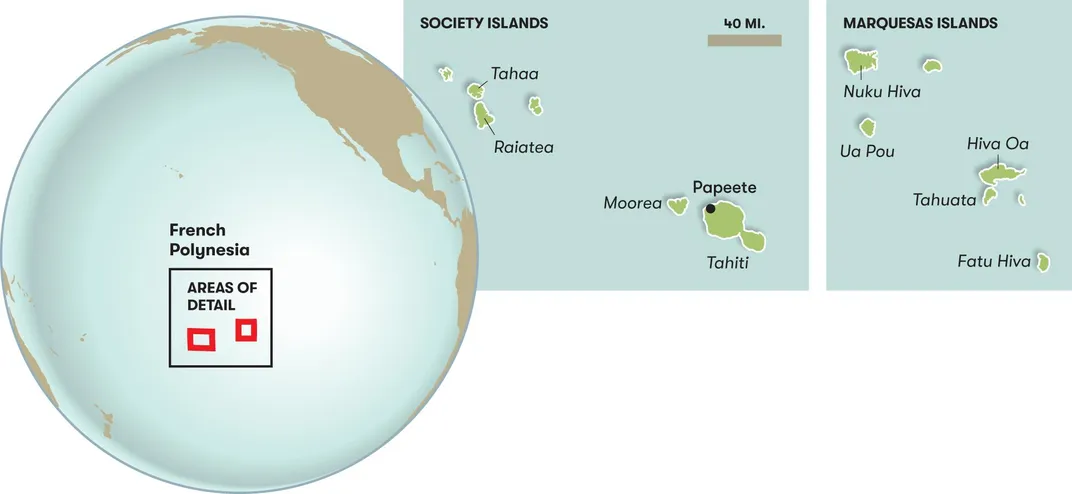
Immediately a rainstorm caused Melville’s party to shelter in “an immense canoe-house which stood hard by the beach.” After the others had fallen asleep, Melville-as-Tom and shipmate Toby Greene crept out and began to ascend the mountain. They would hardly have been daunted by that warm rain. It must have washed away the stink of rotten whale blood and old sweat. They were trading cruel discipline for breadfruit, foul biscuit for mangoes, gravelike berths of darkness for the emerald life that pulsates through Typee. Their hopes were decorated by wild taro with its thick, dark leaves, by those yellow flower-stars on the massive hibiscus trees.
My hopes, after departing Taiohae, were pearl-gray like the water itself. I set out with Jean Pierre Piriotua, a man of Taipi extraction who guided me on Nuku Hiva and agreed to bring me to the valley of his relatives. Passing a cemetery, we next left behind the uninscribed wooden monument to a vagabond named Melville, erected by a local artist in the early 1990s. On Nuku Hiva, light, color and fragrance were as restless as the sea itself. We climbed a cemented road, winding steeply up out of the bay, alongside a banana plantation, with a wet red cliff to the right and sky to the left. Readers of Typee might plausibly infer that Tom and Toby’s ramble begins with a comparable route. (Here I pause to admit that one should never mistake Melville’s narrative voice for literal truth—yet what am I to do? I read his books in a spirit of imaginative empathy, spiced with skepticism.) All too soon, Tom and Toby encounter steep canyons and ridges that bewilder them. Dividing their meager store of bread, they stumble on, weakening, getting soaked at night in makeshift lean-tos. Tom begins to go lame. And then they approach a precipice and gaze down into a paradisiacal valley of “universal verdure.” Unsure whether the valley is home to a supposedly friendly tribe of Nuku Hivans, or to the “ferocious Typees,” our heroes descend into that moist green heaven. And then what? Well, you know from the title where they land.
Having appropriately milked the shock of their choice, Melville promptly begins—and here is what gives Typee much of its richness—to undermine its sinister connotations. First the Taipis feed them, an excellent termination to five starving days. And the blessings continue! They lie down to sleep unmolested. In the morning, nubile members of “the adorable sex” conduct a “long and minute . . . investigation” of their persons.

The powerful chief Mehevi now visits, dressed in a splendidly imposing outfit. What Tom, whose name the chief pronounces “Tommo,” finds “most remarkable” is “the elaborate tattooing displayed on every noble limb.” Most Euro-American observers from this period would have deployed the word “hideous.” Melville asserts that Mehevi “might certainly have been regarded as one of Nature’s noblemen, and the lines drawn upon his face may possibly have denoted his exalted rank.”
And yet—as much as anyone else, Herman Melville was of his time. In Typee he informs us that these “simple savages” can gain “the utmost delight from circumstances which would have passed unnoticed in more intelligent communities.” To condemn Copernicus for not calculating all that later astronomers proved, to expect of Aristotle that he should see the wrong of slavery, is to deserve the future’s most merciless judgment of our own errors that remain invisible to us. Melville could be brave and noble-hearted, for although he was of his time he was also alienated from it. In asserting that “savages” could be justified in resenting their injuries at the hands of “civilization”—a truism to us—he was going against his own interest, and I thank him for it. Inconsistent in his politics, at times truculent, then fearful about his material prospects, among the Taipi this half-formed young autodidact now found his moral compass-needle whirling in the magnetic storms of the unknown.
The scholar Ruth M. Blair proposes that in the character of Tommo, Melville is forming “the complex vision of ‘civilization’ . . . that would put him for the rest of his life out of kilter with his contemporaries.”
4
What most powerfully reorients Tommo’s magnet is “the beauteous nymph Fayaway, who was my peculiar favorite,” one of “several lovely damsels” who make up the co-residents of Tommo’s Taipi Valley abode—an iconic cannibal heroine for all time. Melville describes her at affectionate length. Fayaway was “the very perfection of female grace and beauty,” he says. You see, “each feature” was “as perfectly formed as the heart or imagination of man could desire.” He adds: “This picture is no fancy sketch; it is drawn from the most vivid recollections of the person delineated.” In this portrait, I cannot help but see someone real, someone who was loved.
Many of the people I met on Nuku Hiva believed that “Fayaway” actually existed. They said her name was Peue. Jean Pierre taught me how to say that name: Pah-oo-ay. He said that it meant “beautiful” or “woman.”
Another Nuku Hivan guide who went by Richard Deane—his “local name,” he said, was Temarama, Marquesans traditionally forgoing family names—told me that “Peue means the carpet weaving with banana leaves.” He pronounced her name Peh-oo-weh.
He said, “Peue was the daughter of one chief over there, and they gave her as a gift to Herman Melville to try to keep him in the middle of them, to use him like a white chief and use him like a translator, and bring some new technique of war and technology to fight the strangers”—that is, the Europeans.
“So you think they wouldn’t have eaten him?” I asked.
“No, never.”
(But Jean Pierre thought they might have.)
I asked Jean Pierre, “What do you think of Melville—good or bad?”
“The local people like Melville. A beautiful man with white skin and blue eyes, make him a wife! Peue is wife for important people.”

Not long before the road forked he said: “This mountain, Melville take to Taipi Nui place,” and he pointed across the next abyss. Although he possessed the romantic credibility of a native informant, my certainties had been poisoned by bitter academic contests about Melville’s veracity, and about the topography itself. I thought to myself: How could anybody know?
5
Now we went down into the Taipi Valley, which lay as Melville described it, long and narrow between two high ridges. Inland of the greenish sea with its magnificent clouds, the bay appeared shallow and flat-bottomed. I dreamed my way out into that long stretch of wide ocean. There were many white yachts, which Jean Pierre said were inhabited by foreigners who anchored here “to relax.”
Up the valley ran the river called Vai-i-nui, the big water. The name “Taipi” means “high tide” or “where the river meets the sea.” So here we were, at Taipi. Jean Pierre picked a white pua blossom from a tree, which he placed in his long dark hair.
I had requested to meet any Taipi who might bear Melville among his ancestors, so Jean Pierre drove me to meet his uncle, Monsieur Jean Vainiaanui, “called Pukiki,” as he added in my notebook. “The white of his skin, of the skin of his family, is the same you,” said my guide. “C’est le descendant.”
The front room of the house was dim and moderately cool. The uncle and aunt showed small pleasure at my intrusion. They had met journalists before. Since I myself would have disliked being imposed on in the name of some distant foreign ancestor who had impregnated my greater than great-great-grandmother and then abandoned the family, I kept it short—all the more so since Jean Pierre, who ordinarily stood by me in case I had questions, now strolled outside and left me to my own devices. Perhaps the bargain ran as follows: The uncle submitted to interviews in order to help Jean Pierre make money. In return, Jean Pierre avoided performing any action that would extend those interviews.
Retiring into a dark inner room, Monsieur Vainiaanui returned with a small photoportrait of Melville, which of course impressed me until I learned that a “French friend” (perhaps a journalist) had recently presented it to him.
“Sir, are you a descendant of Melville?”
He said something that sounded like “Pas mari.” I could make no sense of it. A fluent French speaker who reviewed the audio file later concluded: “He really is mumbling, and that was the hardest part to figure out. I believe that he is saying no, that he is not a descendant of Melville, because the first word is definitely ‘pas,’ or ‘not.’”
“For how many generations has your family been here?” I asked Monsieur Vainiaanui.
He was silent, then said: “Many. We live here. My great-great-grandfather came here.”
“How many people are there now in Taipivai?”
“Four hundred.”
“And the people here, they still have memories of Melville?”
“No,” he said calmly.
“What do you think of him? For you, is he someone good or bad?”
“Yes, a good question. Good or bad? I think that Melville was an adventurer; he was someone who wanted to see things. It was normal that he came here.”
“And the people here don’t have any memory of Peue?”
“No,” he said.
Hating myself for having troubled him, I thanked him for the interview and went out.
“So he is Melville’s descendant?” I asked once more.
“C’est possible,” said Jean Pierre.
6
We re-entered Jean Pierre’s truck and drove to a lonely spot in the jungle, approaching the site where Melville might have lived with Peue among the Taipi. Entering the midmorning steam bath, I telescoped my segmented walking stick and launched into another Marquesan perspiration. Jean Pierre was warning about the mosquitoes: “Beaucoup de dengue,” he laughed. (Nearly everybody I asked in the Marquesas had suffered at least one visitation of the fever.) Then we walked down a hill-track that quickly petered out in the shrubbery.
In ten minutes we reached our destination, which according to Typee lay “about halfway up the ascent of a rather abrupt rise of ground,” where “a number of large stones were laid . . . to the height of nearly eight feet.” At no great distance flowed the Vai-i-nui River—evidently the stream in which Tommo and Peue bathed for a half-hour each morning. So far, topography corresponded to description, and there, at a right angle to the slope, rose a flat-topped boulder-eminence of approximately eight feet. Its Taipi name, as transliterated by Melville, was a pi-pi. Upon it would once have risen some family’s house, whose bamboo frame and hibiscus-wood transverses were of course long gone.
Jean Pierre said that this tohua, a central cleared area for clan festivities that at one end might include a place for human sacrifice, had been abandoned generations ago due to malaria, before the dengue fever came.
“How do you know this was the Melville site?”
“Because my grandfather told me,” Jean Pierre said.
Mostly the tohua was a jumble of rocks, the ground overgrown to an ankle’s thickness by an ivyish plant that had been imported from New Zealand to feed the cows. Here where Melville and Peue used to “stroll along,” “sometimes hand in hand,” with “perfect charity” for all “and especial good-will towards each other,” I took my own promenade—until Jean Pierre warned me against falling coconuts. In 2007 a tourist and her guide were killed by them at a scenic waterfall nearby.
Sitting on a mossy wet boulder, I gazed down a steep wall of rocks to the river. My knees were glowing with bites. Below was a pavement of white-lichened boulders and the lovely breeze and the brown-green Vai-i-nui, a rapid creek. In its flow the wading Taipi maidens used to soak their coconut shells and polish them with stones.

I picked a hard green lime from its thorny branch. It was very fragrant. When we stopped for a cheese and cracker lunch, Jean Pierre cut it for me with his machete, so that I could squeeze it into my water bottle.
7
One of the characteristics of Typee most offensive to 19th-century Americans was its unashamed eroticism. (Another was Melville’s rage against the missionaries.) When he began composing it, he “went far indeed in planting not just sensuous but actually obscene passages in his decorous manuscript,” writes his biographer Hershel Parker. Omitting those, let us content ourselves with lesser innuendoes: “Bathing in company with troops of girls formed one of my chief amusements.” “There was a tenderness in her manner that it was impossible to misunderstand or resist.” “Every evening the girls of the house . . . would anoint my whole body”—your whole body, Herman?—“with a fragrant oil, squeezed from a yellow root.”
Our hero was apparently living easily. But then what? Just as the red, white, yellow and green flower garland that my Taiohae femme de ménage Isabelle draped round my neck smelled so spearmint-bright at first, then wilted and began to stink, just so it was, my friends, for poor old Tommo! You see, he kept worrying that his Typee hosts would eat him.

What if those ill thoughts were mere embellishments, and the simple truth was that the joy had drained from his sojourn in Taipivai? “The gods themselves are not for ever glad,” he writes in Moby-Dick. “The ineffaceable, sad birth-mark in the brow of man, is but the stamp of sorrow in the signers.”
Most likely is that being ignorant of the Marquesan language and culture, he simply did not know whether he was on the menu.
8
Let me describe a certain weird old ruin on the far side of the island. A honey smell came in the evening breeze, and I heard a crowlike croaking. Palms bent together and whispered behind the long, low walls of a wide-stepped terrace. I heard a fluttering sound, then a bird began calling waaa!, and everything stayed motionless on the black basalt platforms. In the humid twilight, the platforms with their white lichen began to look sinister. My eye was held by a single banyan tree, maybe 500 years old, which sprang upward like some grisly and sacred entity upon an altar. The clouds darkened; the terraces were already silhouettes; the leaves began to go utterly dark.
By the time that Jean Pierre led me to it, the site’s famous petroglyph boulder could barely be seen. Of its depictions I most remember the great turtle, represented because turtles come from the sea to lay eggs, then perish; hence after we die, our spirit goes likewise to the sea; thus the artist might have believed, Jean Pierre said, “maybe a thousand years after Christ.”
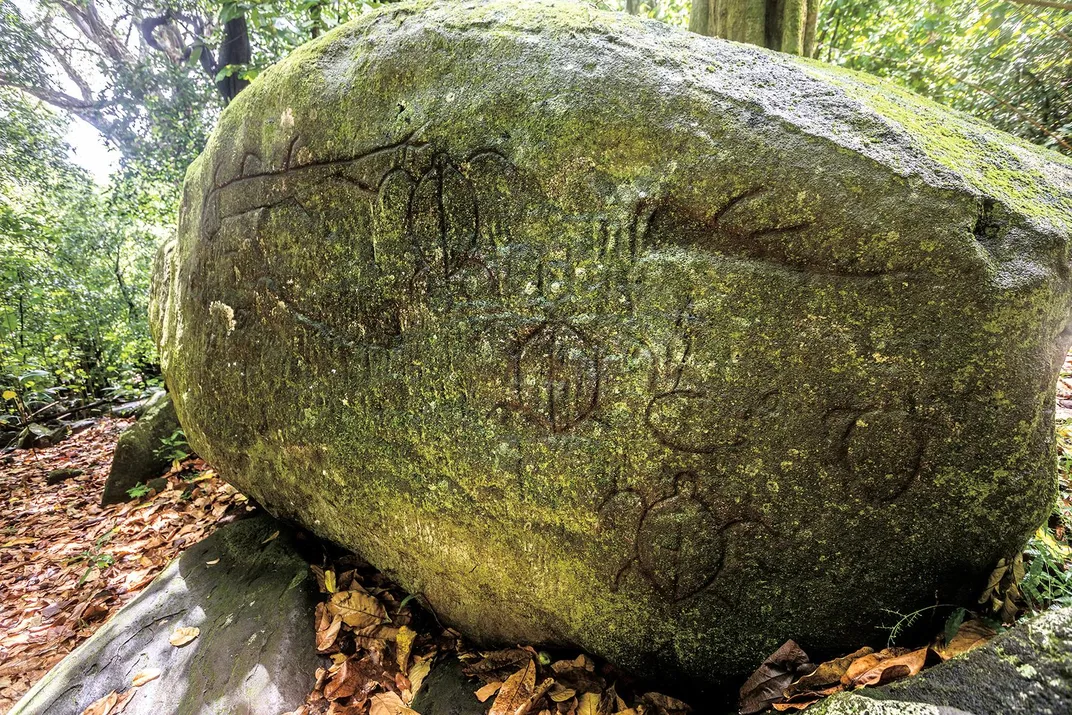
Feeling my way with my walking stick, I tapped from boulder to boulder. Jean Pierre pointed into a deep pit, dark against the darkness, which he called the ancient calaboose. Really it was more like a meat locker—the place where captured enemy warriors were kept until eating time. Imagine being a lonely guest near any such place (and every clan had one), among people with whom one could scarcely communicate. How could Melville know what the smile of Peue really signified, or whether Kory-Kory, his gentle manservant, might suddenly take on a butcher’s role?
9
All we know of his escape—overwrought in Typee, which is not to say false; the indigenes may have peacefully traded him back to the Europeans—is that in August 1842 our author ended up on the whaler Lucy Ann, an adventure he drew on for Typee’s sequel, Omoo. Short-handed thanks to desertions, the ship’s captain rescued Melville, who signed on to cruise as far as Tahiti. Reasonably fearful of more desertions, at Tahiti the captain forbade his men shore leave; thus did Melville, insubordinate as always, join a mutiny. (It failed.)
In Tahiti they threw him in Calabooza Beretanee (Melville’s transliteration), which in Tahitian means “English jail.” I would have liked to see this place, but nothing remained of it. Our author had his little ways; soon his confinement was relaxed, then remitted, and he found himself a vagrant once again. In the time he was in Tahiti, he observed white missionaries invading people’s homes at mealtimes, while native constables dragooned whomever they could catch to Sunday services. The new moral code was punitively enforced; the education system was a sort of apartheid. Omoo bitterly describes the cane-thumping old missionaries at whose sight the natives “slink into their huts.” Melville could only conclude that “the Tahitians are worse off now” for the encounter.

In Papeete, French Polynesia’s capital, on Tahiti, my pension host Luc François did not disagree with Melville. “I wish the missionaries stay at home, because they say their god is better than other god!” He laughed. “They say, ‘Now you have to pray to my god, you have to put on a dress, you have to hide a tattoo.’ But my tattoo is my clan’s story, my children’s story. But they say, ‘My god don’t like!’ We are a small place, a small piece of the universe. Why come to me and say like that?”
With native culture changed, Melville concluded that the islanders’ “prospects are hopeless.” The English-language guidebook whose job it was to entice me here, so that I could inflict my own mite of cultural damage, admitted that “domestic violence and incest are prevalent. This is closely connected with high rates of alcoholism . . . little progress has been made.” I found the guidebook’s final assessment off the mark. For one thing, Tahiti’s inhabitants, about 9,000, according to Melville, now numbered nearly 200,000. Some of them smiled at me, right there in Papeete’s motionless humid shadows, with traffic’s soft hum all around me as I sat in a grove of palm trees, entertaining people with my compliments in bad French. At night they danced for each other, not for money. Their language still lived.
10
Around November 1842, Melville decamped for the island of Moorea. Finding himself pressed into unhappy work digging potatoes, he decided to visit a village called Tamai, where “dwelt the most beautiful and unsophisticated women.”
For the sake of scholarship, I tootled over to Tamai, now orthographized Temae, and in a different part of the island than where Melville had put it. He spoke of a lake; yes, I did see a body of brackish water beside the airport; its shallows were stringy with algae and littered with rotting coconuts. Some days after viewing the “passionate” movements, “with throbbing bosoms,” of those Temae sylphs, Melville received warning that the law was coming; fearing that he would be arrested for vagrancy, he had to clear out.

I next lay down in a concrete pavilion by the turquoise ocean with its reef line just before the horizon. Ten days after fleeing the constables at Temae, Melville marched into this exact spot. He was expert as ever at accepting the hospitality of Polynesians. Bathed, sated and dressed, he took the time to admire coconut oil burning inside a lamp made from half a green melon, “a soft dreamy light being shed through the transparent rind.” And here I want to say that so much of his Polynesian writings have to do, as well they should, with the pleasures of idleness, and even somnolence.
The slender, middle-aged Papeetian lady whose machete opened a juice-coconut for me had never heard of Melville; she wondered if that might be my name. The radio was playing an old song I always liked about going to San Francisco. On the way out of town a sign warned of false prophets.
11
Finally, Melville shipped out on the whaler Charles and Henry. Sometime between January and March 1843, he arrived in Hawaii, then called the Sandwich Islands. Most of his doings there cannot be verified. He might have landed at Lahaina. We know he passed some time in Honolulu, where he signed a one-year contract to work as an Englishman’s bookkeeper. Meanwhile the Acushnet, which had also arrived in Hawaii, posted a complaint of desertion against him.
In August 1843, having characteristically broken his contract, Melville enlisted on the USS United States. They landed at Nuku Hiva in October, then came a week anchored just off Tahiti, and that was the last he ever saw of Polynesia.
By now the shy young innocent had found his sea legs. He could defy, desert, blaspheme and fornicate with the best. He had grown comfortable with the fact that “from the wild life they lead . . . sailors, as a class entertain the most liberal notions concerning morality and the Decalogue.” And indeed, as Charles Roberts Anderson rather sourly writes on the last page of his 1939 tome Melville in the South Seas: “Within a decade the high priest of the South Seas had become, in his own eyes at least, the heretic of an inquisitional civilization.”

Melville hated restrictions on his liberty; hence his mutinies and vagabondage. So he kept right on calling out authority, ranging ahead in a long cruise toward unfettered self-expression,
which in our world naturally equals self-destructiveness. Of Hawaii, he wrote, “What has [“the savage”] to desire at the hand of Civilization?...Let the once smiling and populous Hawaiian islands, with their now diseased, starving, and dying natives, answer the question. The missionaries may seek to disguise the matter as they will, but the facts are incontrovertible.” Defiant always, with ever-growing daring in his style, he sailed in the direction of his unknown greatness.
12
And so he came home to his America—by no means to ours. “Thrice happy are they who, inhabiting some yet undiscovered island, have never been brought into contaminating contact with the white man,” runs Typee. It follows that he had contaminated them, and they most certainly did him the same favor.
He wrote to Nathaniel Hawthorne, whom he adored, that he “had no development at all” until age 25, which is to say, around 1844. In that year he began to write Typee. The Harper brothers rejected it a year later. His brother Gansevoort, who remained the family’s support, carried it to the London publisher Murray, who printed it moderately bowdlerized in 1846. Almost immediately, thanks to the writer Washington Irving, Typee gained an American publisher, George Putnam.
The first reviews were favorable—and no other book of his ever sold so well. It made him famous. But on March 14, a British periodical, The Critic, said: “Seldom have savages found so zealous a vindicator of their morals; rarely, too has Christianity owned so ungrateful a son.” Although Typee and then Omoo continued to garner praise, attacks on his Christianity, bolstered by Horace Greeley’s denunciations of his “hankering for loose company not always of the masculine order,” began to undo Melville’s career.
When Gansevoort died suddenly in 1846, the young author had to increase his efforts to support his penniless old mother. Fortunately, he had attracted the rich and pretty Elizabeth Shaw.
What did she see in him? He was handsome—fascinating—a storyteller. He must have seemed someone of promise. In other words, he happened, in that weird interlude between when he was forgetting Peue’s excellence at playing the nose flute but was scarcely yet imagining the long bulk of the white whale gliding toward the Pequod, to be capable of what most people call “responsibility.”

Pressured by his American publisher into reprinting Typee with numerous anti-missionary and erotic expurgations, he went along, hoping for some future income guarantee—for he craved to marry Lizzie, whose father did not intend to throw her into poverty.
With that self-destructive defiance I love him for, he sharpened his harpoon against the missionaries, quite gleefully, in Omoo. Nor did he desist. Hershel Parker writes that he finally “settled” his “grudge against his Presbyterian accusers and tormenters” in Chapter 10 of Moby-Dick, in which Ishmael worships the cannibal Queequeg’s wooden idol.
But that actually settled nothing. Again and again the great white whale of Judeo-Christian conformity smashed at his morals. Lizzie had hoped to marry Herman in church, “but we all thought,” she wrote in a letter, that “if it were to get about previously that ‘Typee’ was to be seen on such a day, a great crowd might rush out of mere curiosity”—or worse.
On August 7, 1847, three days after the wedding, the Daily Tribune chuckled: “BREACH OF PROMISE SUIT EXPECTED MR. HERMAN TYPEE OMOO MELVILLE has recently been united in lawful wedlock to a young lady of Boston. The fair forsaken FAYAWAY will doubtless console herself by suing him....”
13
The Melvilles lived on Lizzie’s father’s money. To improve his reputation, which is to say his finances, in 1849 Herman rushed out Mardi and Redburn, followed by White-Jacket the next year, all tales of a novice at sea. These mollified, if they did not excite, reviewers: “Mr. Melville seems likely to go ahead again, if he will only take time and pains, and not over-write himself.” In the best fashion of any career-suicide, he regarded both latter volumes with contempt, writing to Lizzie’s father (who may not have been delighted to hear it) that “it is my earnest desire to write those sort of books which are said to ‘fail.’”

As if to prove the point, he now commenced his deep dive. He wrote in an adulatory essay about Hawthorne’s fiction: “Now it is the blackness in Hawthorne...that so fixes and fascinated me. This blackness it is that furnished the infinite obscure of his background—the background, against which Shakespeare pays his grandest conceits.”
What grand conceit could gambol to most contrasting advantage against a black background? Something white! And why was this whiteness something to write about, to dread, to be haunted by? It could be, as Melville wrote in “The Whiteness of the Whale,” the famous 42nd chapter of his opus, “that by its indefiniteness it shadows forth the heartless voids and immensities of the universe, and thus stabs us from behind with the thought of annihilation.” Who was Melville but a man impelled by the unknown? What remained for him but to voyage beyond everything, to the place where infinity is nothingness, and black and white contain each other?
By now the Melvilles had moved near the Hawthornes in the Berkshires, into the house they called Arrowhead. (Our hero mortgaged it twice over.) And so the former sailor shut himself up tight. Years later, his widow remembered that he “would sit at his desk all day long not eating any thing till four or five o clock—then ride to the village after dark—Would be up early and out walking before breakfast.” All the while he was borrowing money and more money, keeping his debts secret.
“What I feel most moved to write, that is banned—it will not pay,” he wrote to Hawthorne. “Yet, altogether, write the other way I cannot.” Then for a brief moment he blinked at what was immutably decreed, temporarily lost faith in his own Shakespeare-black fatality, and added: “So the product is a final hash, and all my books are botches.” By then Moby-Dick was getting set in type.
14
A certain underwater photograph in my edition of The Wreck of the Whaleship Essex shows a sperm whale headed forward like a finned gray-green torpedo, its lower jaw a strangely narrow appendage to the underside of that vast and squarish head. Such was the whale that stove in the Essex, such must have been the whale in Moby-Dick: rushing to smash in everything, so that Melville’s greatness could come into glory.
In our day, the inhabitants of a biologically diminished planet may feel more sympathy than awe for “that unexampled, intelligent malignity” of the famous white whale, but what makes him such a hauntingly great literary character is his utter, and therefore utterly unreadable, alienness, an infinite magnification of the exotic otherness that his creator had sought in the South Pacific.
Toward that oncoming collision between the whale and the Pequod, Melville wrote his way forward, employing wife or sister as copyist, ducking his mother’s monitory religiousness, going deeper and darker into the sea, so that in the end he could take us down with him.
He maintained his defiance with a core that was strangely sweet. From Moby-Dick: “For as this appalling ocean surrounds the most verdant land, so in the soul of man there lies one insular Tahiti, full of peace and joy, but encompassed by all the horrors of the half known life. God keep thee! Push not off from that isle, thou canst never return!”
15
So what is this novel, with its what and why never entirely explained, its characters never “developed”? What fits it better than the “dimly-discernible greatness” of a great mind, as Melville wrote of Shakespeare? And so comes the bewitching climax and ending of the book, with sharks eating the oars of the whaleboats that row in fated pursuit of that white monster who exemplifies blankness, glory, malice and divinity.
It was published in 1851. The British version came out lacking the epilogue, in which Ishmael reveals himself as the sole survivor of the whale-stove Pequod. Accordingly, Melville was denounced for his apparent carelessness in crafting a first-person narrative in which everybody dies. The American version did contain the epilogue, but some reviewers quoted idiotically from the British dispraise. A few Americans were kind. One reviewer who might have been Horace Greeley spoke of its “originality and power.” The Springfield, Massachusetts, Republican found it “a large and interesting web of narrative,” although “there is no Fayaway in it. Alas! fickle and forgetful Melville, that thou should’st ever forget the gentle native who gave herself to thee.” Worse yet, the book’s “profanity and indecency,” warned a Congregationalist newspaper in New York, “makes it impossible for a religious journal heartily to commend any of the works of this author which we have ever perused.”
That said it all. His in-laws mostly turned against him; his mother deprecated his many blasphemies; his wife and sisters began to lose their belief in him.
16
After writing the epic parable of a man who unrelentingly pursues the mystery that destroys him, Melville turned, as they say, inward, or at least landward. He must have been coming apart by then; whenever the blasts of poverty, humiliation, hatred, derision and disappointment pierced him, he came apart more dramatically, the way a sailing ship might unravel in a typhoon, its rigging all a-squiggle like a cat’s hair standing on end.
What he had written concerning Ahab now became applicable to himself: “God help thee, old man, thy thoughts have created a creature in thee; and he whose intense thinking thus makes him a Prometheus; a vulture feeds upon that heart for ever; that vulture the very creature he creates.”
17
His American publisher, the Harpers, who had already forced him into ruinous financial terms, disavowed his next work, Pierre—alas, a novel about a desperate writer coming undone. His kindly British publisher offered to bring it out, but not soon, and without any advance. Distraught, Melville never answered; thus ended his independent publication on the other side of the Atlantic.
That was in 1852. In May 1853 he completed The Isle of the Cross. The Harpers rejected that book, which was subsequently lost; he might have burned it. But because his past book failures had left him in debt to them, they permitted him to write anonymously for their magazine. He also wrote for the periodical Putnam’s. Over the next year, for them he produced his greatest short stories: “Bartleby, the Scrivener,” whose “I would prefer not to” haunts us to this day, and the brooding, ironic “Benito Cereno,” in which an apparent reality gets turned inside out. In both tales, we find the inverse of those youthful, good-hearted generalizations about otherness that stud the pages of the South Seas novels. Meanwhile, their author got rheumatism and defaulted on his debts.
Although Melville lived 40 years after Moby-Dick, they were hardly good years. Let me therefore heed the dictum put forth near the end of Israel Potter, his 1855 novel of the eponymous Yankee rebel imprisoned in Britain. “Best followed now is this life, by hurrying, like itself, to a close. Few things remain.”

Having lost Arrowhead as a result of his debts, the family removed to New York. In 1857, The Confidence-Man was published. It earned him “not a penny.” His various poems did no better, even his “impeccably patriotic” ones.
About the time the Civil War started, his generous father-in-law died; the legacy to Lizzie allowed her to provide for the family for a little while. In 1866 her husband finally got a job, drudging as a customs inspector in New York for a grand $4 per day. He kept at it for almost 20 years.
18
By 1867, writes Hershel Parker, “the Shaws were saying Lizzie believed that Herman was insane.” She seems to have considered separating from him. That same year their son Malcolm accidentally or deliberately shot himself in bed, dead at 18.
Nine years later, when Lizzie was helping him read the proofs for his vanity-published poem “Clarel” (which the New York Independent pronounced “destitute of interest or metrical skill”), she wrote in a letter that he was in “a frightfully nervous state.”
In 1886 he finally retired from the customhouse. Five years later, with Billy Budd, another masterpiece, unfinished, he died—appropriately enough, of an enlarged heart. After running a belated obituary, the New York Times published a pleasant enough memorial “THE LATE HIRAM MELVILLE.”
Fashions change. Now we praise Melville for his darkly beautiful obscurities, the oceanic swells of alterations from story to essay to joke and back again. In Why Read Moby-Dick?, an extravagant little volume from 2011, Nathaniel Philbrick interpreted that masterwork as a cosmic repository for our national destiny: “Contained in the pages of Moby-Dick is nothing less than the genetic code of America: all the promises, problems, conflicts, and ideals that contributed to the outbreak of a revolution in 1775 as well as a civil war in 1861 and continue to drive this country’s ever-contentious march into the future.”
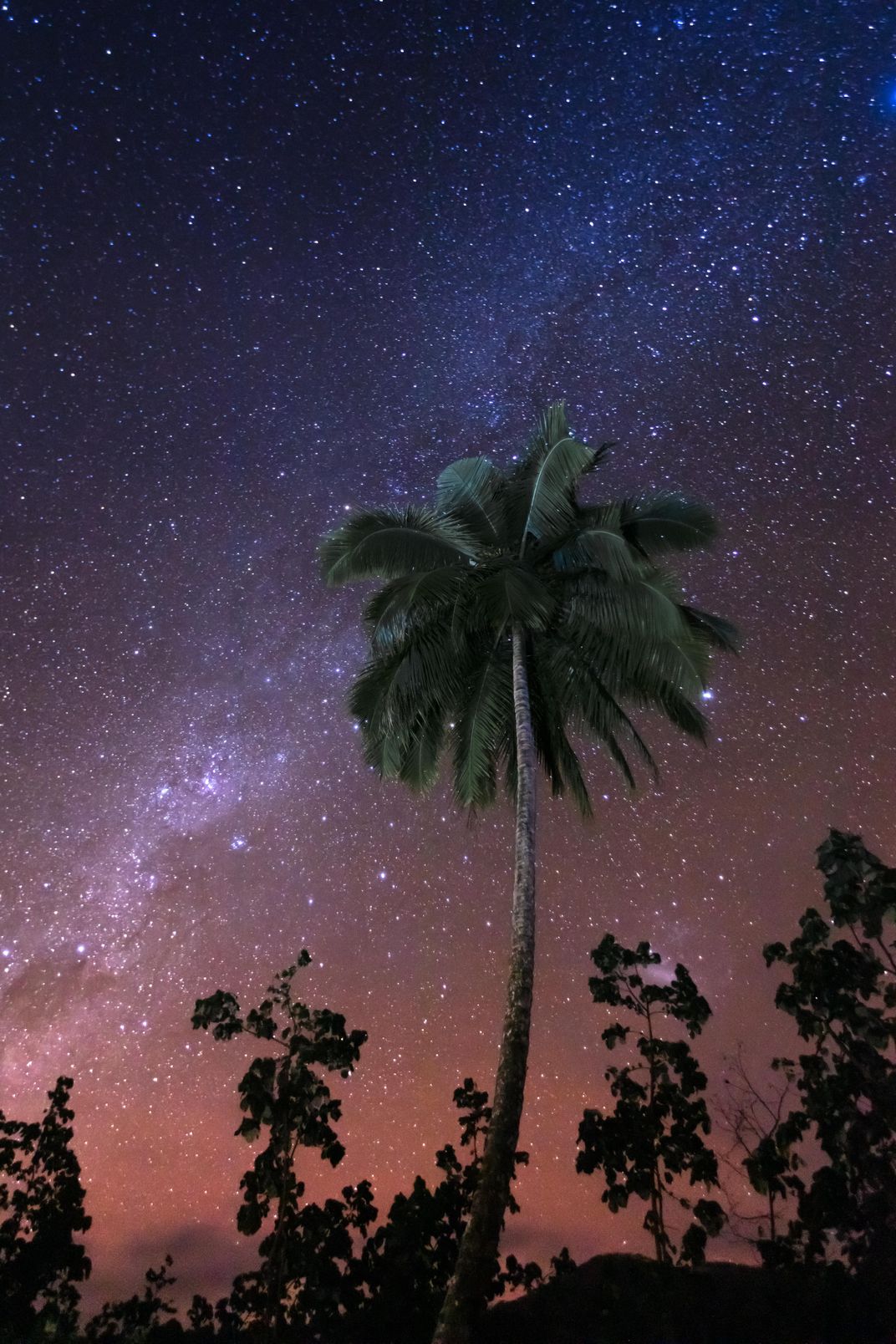
I praise Melville because in at least one way he was an ideal American: He celebrated the equality of all our brothers and sisters. How many other Americans of his era could have written so tolerantly, even lovingly, of the tattooed cannibal harpooner Queequeg? “And what is it, thought I, after all! It’s only his outside; a man can be honest in any sort of skin.” Whether or not Queequeg ever existed, or Fayaway was Peue, Melville brought Polynesia back within him, and showed his greatheartedness by honoring it.
19
And now ever after when I reread Typee, I will remember the emerald green jungle; Omoo is all ocean and islands, blue and green. Moby-Dick encompasses the two poles of colorlessness: deep undersea darkness, the ultimate destination of the Pequod and all of us, which is to say the home of the white whale.
But no—while I call Typee an emerald book, anyone who craves the dark depths of Moby-Dick need only descend the wriggling road below those smoothed-out saw blades of the Taipi Valley, with the night clouds still faintly luminescent, the valley black with ferns and leaves leaping at the eye at each switchback, the abyss itself a reified negation.
Here comes another banana tree, a golden spider in the headlights. The dark mountains go higher and higher up the windshield; the road stays pallidly ugly. Infrequently I glimpse white trunks of trees in the darkness; I smell humus. By now we have descended so far that the sky is nearly out of sight. A little more than 500 feet from the trail to the “tohua Melville,” I discern nothing but darkness between the pale trees. Then we are there, with the plants like white skeletons, drowning in more darkness; from down there where Melville used to live, I smell moss, and hear a dreary rustling.

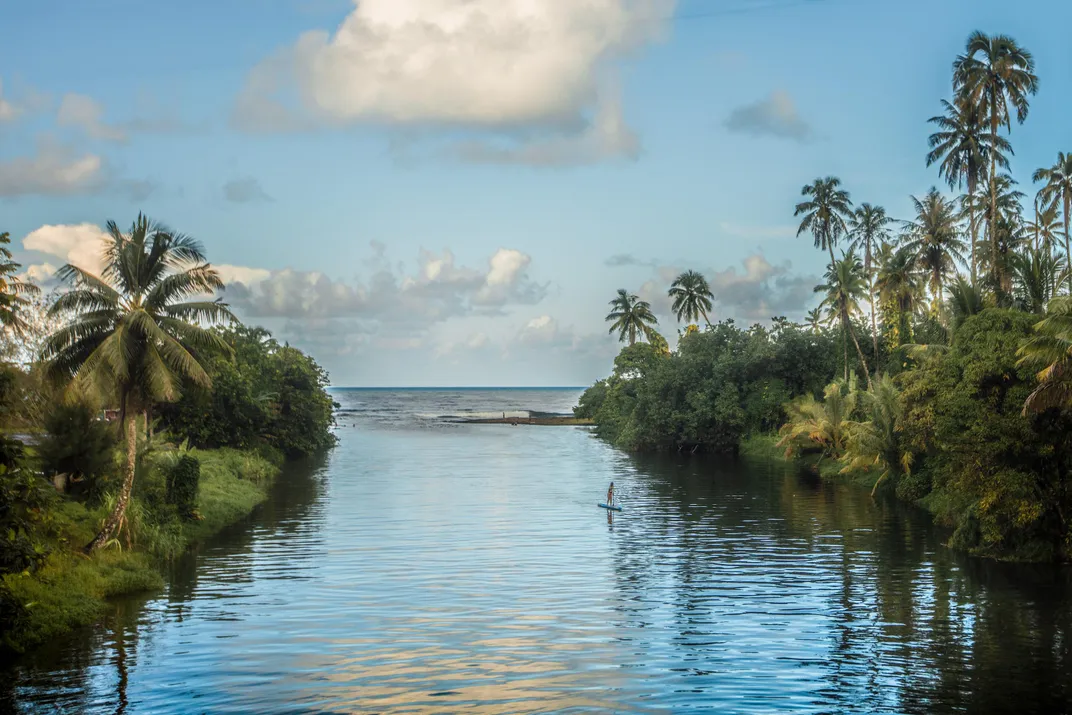
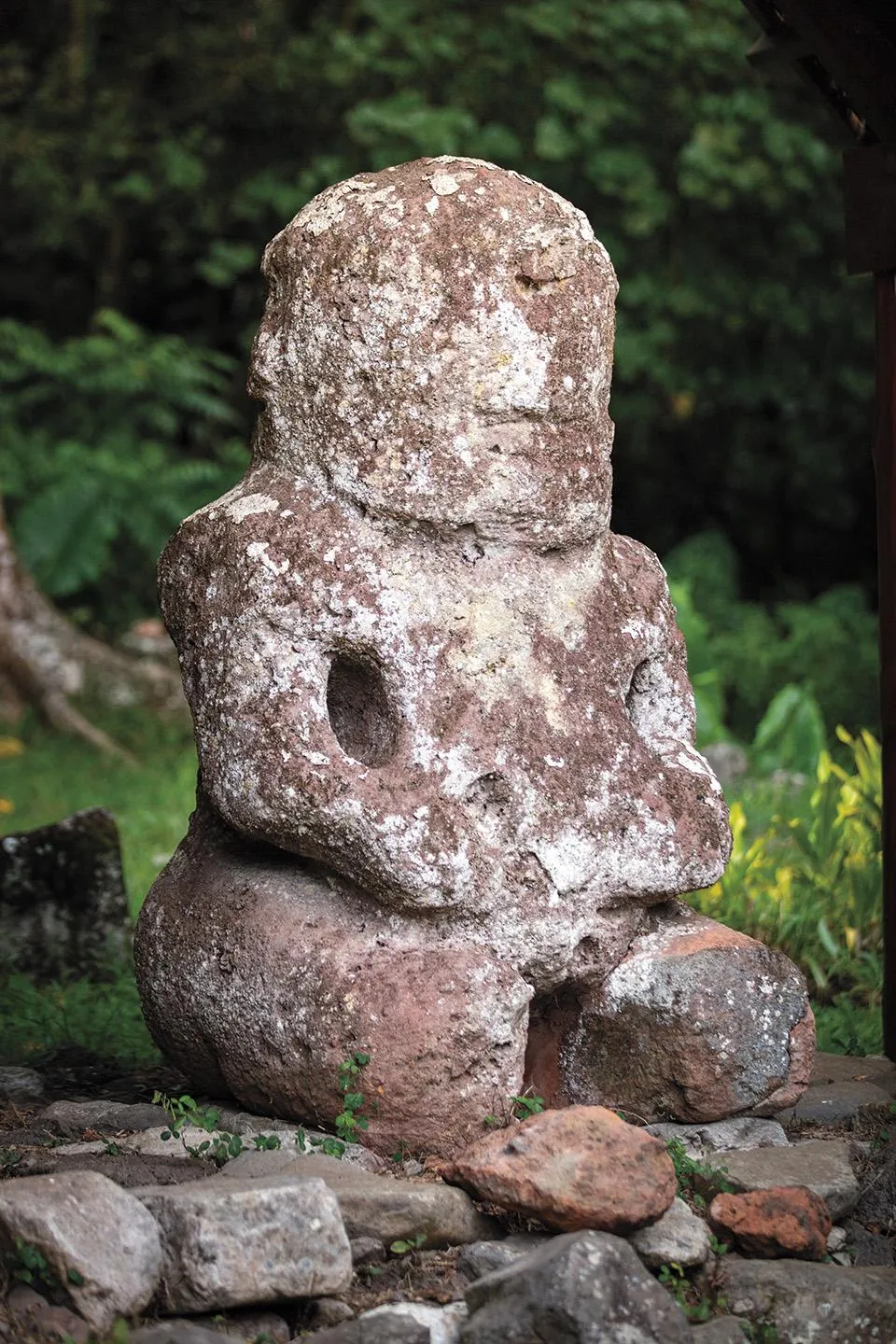

No comments:
Post a Comment